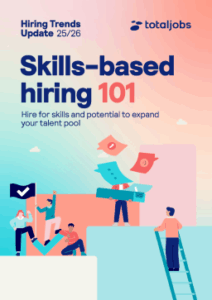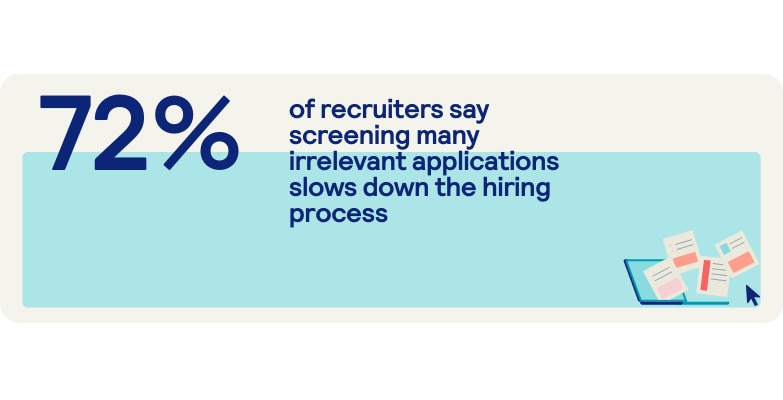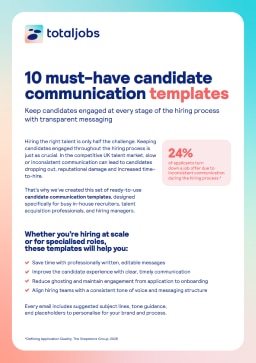
6 proven strategies to reduce time to hire
Table of Contents
- What is time to hire?
- How to reduce time to hire
- Fast hiring starts with smart processes
- FAQs

Hiring Trends Update Factsheet

Skills Based Hiring Template
Did you know that 78% of jobseekers are likely to drop out of a hiring process that takes too long? Every delay increases the risk of losing top candidates to faster-moving competitors and leaves roles unfilled longer than necessary.
Backed by our research, this article outlines six proven strategies to help you hire faster without sacrificing quality. Let’s dive in.
What is time to hire?
Time to hire refers to the number of days between the moment a job opening is advertised and the day a candidate accepts the job offer. It’s a key recruitment metric that reflects how efficient an organisation’s hiring process is.
Our research shows that across industries in the UK, the average time to hire is around 8 weeks, meaning it takes UK employers roughly two months from launching their search for a new employee to a candidate accepting an offer. This figures changes to 7 weeks for SMEs and 9 weeks for large businesses.
Time to hire = Job advert date – Offer acceptance date
Understanding the concept is essential when considering how to reduce time to hire, as it highlights where delays may be happening in the recruitment process. A shorter time to hire means you’re moving quickly to secure top talent, often before competitors get the chance.
Why is time to hire important?
A lengthy hiring process can negatively affect productivity, employee morale, and business outcomes.
That’s because leaving roles unfilled for too long forces existing staff to take on additional responsibilities, which often results in teams feeling:
- Overworked
- Undervalued
- Stressed
Beyond internal strain, prolonged hiring delays can result in:
- Missed project deadlines
- Declining service levels
- Reduced team performance
Reducing time to hire helps employers fill vacancies faster, minimise disruption, and improve overall efficiency. More importantly, it gives organisations a competitive edge, making it possible to secure in-demand candidates before they are tempted by other offers.
How to reduce time to hire
From efficiently screening candidates to implementing a structured, speedy interview process, there are plenty of techniques employers can deploy to recruit top candidates while also reducing time to hire.
Let’s look at some of the recruitment strategies you can utilise to reduce a time-consuming or overly complex talent acquisition process.
1. Use the most effective sourcing channels
Not all sourcing methods yield equal results. And with 66% of recruiters saying hiring is a challenge, and 70% citing difficulties finding candidates with the right skills, flexibility and prioritisation are key.
According to our research, 70% of recruiters say that paid job listings result in the highest number of hires. For large businesses, that figure rises to 73%. Other high-performing channels include:
- Careers pages or direct applications (71% for large companies)
- Employee referral programmes (68%)
- Upskilling or reskilling partnerships (especially among SMEs at 71%)

Tip: Focus on what works and continuously measure performance by channel to allocate your resources effectively.
2. Automate time-consuming tasks
Admin is often a silent time-killer in the recruiting process.
We found that the average recruiter spends over 17 hours per vacancy on tasks like CV screening, data entry, and scheduling interviews. That translates to more than two workdays lost, or over £16,728 per recruiter per year.
Some of the most inefficient areas include:
- Screening irrelevant applications
- Uploading post-interview notes
- Managing back-and-forth with hiring stakeholders
Automation tools, including AI, are already making an impact. For example, 27% of recruiters now use AI to help write job ads, and 25% use it to review CVs. These tools not only save time but also help eliminate human bias and inconsistency.
3. Streamline candidate screening
The average recruiter receives 20 applications per vacancy, but only 50% of applicants are actually qualified. Recruiters therefore spend a significant amount of time screening CVs, around 3.6 hours per role.
Unsurprisingly, 72% of recruiters say screening irrelevant applications significantly slows them down.
Fortunately, there are numerous ways to reduce this burden, such as:
- Using screening questions to filter out unqualified candidates early
- Introducing smart resume parsing tools
- Clarifying role requirements more explicitly in job ads to avoid misaligned applicants

4. Improve stakeholder communication
Our research found that as many as 71% of recruiters cite delays from hiring managers as a key drag on time to hire. Time spent aligning on decisions, collecting feedback, and chasing approvals adds up to over 9 hours per vacancy.
Furthermore, poor processes can also result in missing out on qualified candidates. We found that 86% of candidates are less likely to accept an offer from a company with a poor hiring process.
To overcome these delays and avoid hiring bottlenecks, employers can establish a defined process for internal communication and expectations, including:
- Scheduling fixed check-in points for feedback
- Using shared digital dashboards to track progress
- Pre-aligning on candidate criteria during intake meetings
5. Actively work to keep candidates engaged
A successful hiring process isn’t just about internal efficiency. It also needs to keep candidates engaged.
As things stand, 28% of candidates drop off during the process, with the most common reasons being:
- The process took too long (25%)
- Communication was unclear (23%)
- Role expectations weren’t clear (21%)
As a result, employers need to work harder than ever before to keep candidates in the funnel and avoid drop-offs. This can be achieved by:
- Offering clear timelines and regular updates
- Being transparent about role expectations and salary (the top priority for 54% of jobseekers)
- Using application status trackers, something 77% of candidates say would improve their experience
6. Rethink the interview process
Employers often underestimate how much time is wasted during candidate interviews.
We found that both SMEs and large organisations feel interview rounds are too long or too frequent. Follow-up work like feedback collation and coordination also adds further unnecessary delays to an already time-consuming process.
Streamlining the process and implementing interviewing best practices can help reduce the time interviewing takes and ensure optimised hiring decisions. Employers should consider:
- Limiting interviews to two rounds where possible
- Pre-agreeing evaluation criteria
- Assigning clear responsibilities for post-interview feedback

Uncover tips and techniques for conducting structured and productive interviews in our complete guide
Faster hiring starts with smarter processes
Reducing time to hire doesn’t mean cutting corners. It means cutting waste. By using effective sourcing channels, automating admin, aligning internally, and keeping candidates engaged, employers can streamline recruitment and secure top talent faster.
So, remember to evaluate where bottlenecks occur in your hiring process and implement tech or process changes where needed. The quicker you can make a confident offer, the more competitive your organisation becomes in the hiring landscape.
Frequently asked questions (FAQs)
How can I reduce time to hire in recruitment?
To reduce time to hire, streamline your process by:
- Using high-performing sourcing channels
- Automating manual tasks like CV screening and interview scheduling
- Setting clear timelines and expectations with hiring stakeholders
- Keeping candidates informed and engaged
What are the main causes of long hiring processes?
Some of the biggest timewasters in hiring include:
- Screening irrelevant applications
- Slow feedback from hiring managers
- Poor coordination between stakeholders
- Too many interview rounds or delayed decision-making
What tools help automate recruitment?
Recruiters use automation tools for:
- Writing and publishing job ads
- Screening CVs with AI
- Scheduling interviews
- Sending offer letters and rejection emails
- Tracking candidate status in real time
How does AI reduce time to hire?
AI reduces time to hire by:
- Filtering applications more quickly and accurately
- Recommending best-fit candidates
- Automating administrative steps (e.g. data entry, documentation)
- Assisting with post-interview analysis and candidate ranking
Why is reducing time to hire important?
A shorter hiring timeline improves:
- Candidate experience and engagement
- Offer acceptance rates
- Business continuity and productivity
It also prevents top talent from accepting roles elsewhere during long delays
Explore articles
Receive the latest recruitment resources and
advice to boost your hiring
By providing us with your details you agree to our privacy policy and for us to keep you updated with the latest news, events,
and special offers from Totaljobs.









